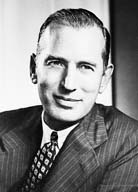 Crawford Hallock Greenewalt (16 August 1902 – 28 September 1993) was an American chemical engineer who served as president of the DuPont Company from 1948 to 1962 and as board chairman from 1962 to 1967.
Crawford Hallock Greenewalt (16 August 1902 – 28 September 1993) was an American chemical engineer who served as president of the DuPont Company from 1948 to 1962 and as board chairman from 1962 to 1967.
After graduation from the Massachusett Isnstitute of Technology in 1922 with a B.S. degree in Chemical Engineering, Greenewalt spent his entire professional career with Du Pont. Starting as a chemist at the Experimental Station, he rose through the ranks to become president (1948) and chairman of the board (1962-1967).
During World War II, Greenewalt was technical director of the Du Pont plutonium plant at Hanford, Washington. In 1942, he witnessed the first controlled atomic reaction at the University of Chicago stadium.
In the early 1950s, Greenewalt was fascinated by watching birds take off from a window feeder.
He devised photographic equipment to determine their rate of accelerationt o flight speed. In cooperation with the late Harold E. Edgerton of the MassachusettsIn Institute of Technology and engineers of the Du
Pont Company, he developed high-speed photography capable of "freezing" the rapid wing beats of hummingbirds.
Three major publications followed as his interest in birds grew. "Hummingbird" dealt with the unique flight characteristic of these diminutive birds. His photographs of many species were made in Brazil with the assistance of the late Augusto Ruschi. "Dimensional Relationships of Flying Animals dealt with the size and other parameters of flight in birds, mammals, and insects.
"Bird Song: Accoustics and Physiology" is a highly technical analysis of songs and other vocalizations of birds. In addition, "The Uncommon Man, the Individual in the Organization" is based on Greenewalt's
1958 McKinsey Foundation Lectures at Columbia University.
Ornithologists will long be indebted to Crawford Greenewalt for his pioneering contributions to their discipline. He was the recipient of 20 honorary doctorates.